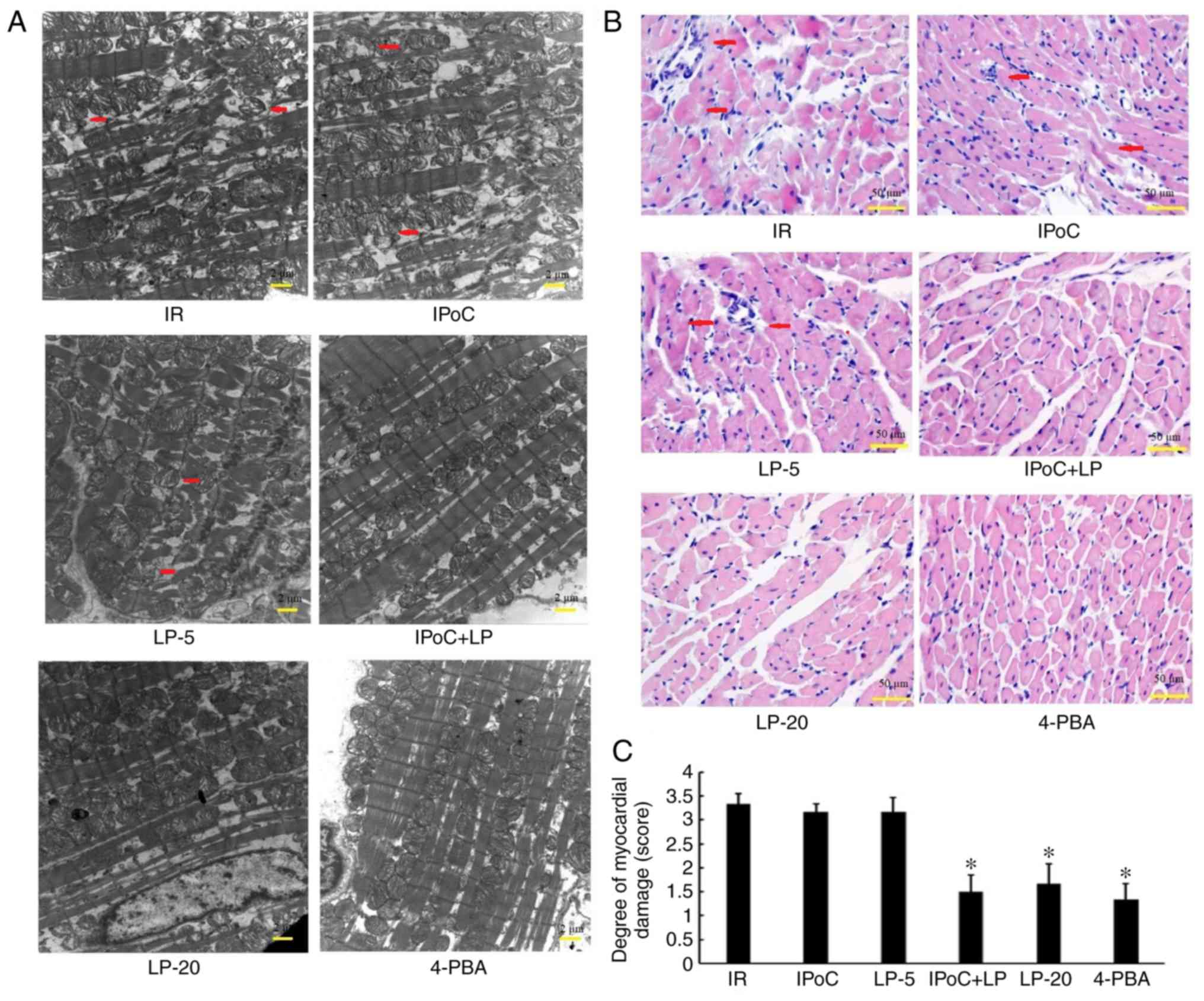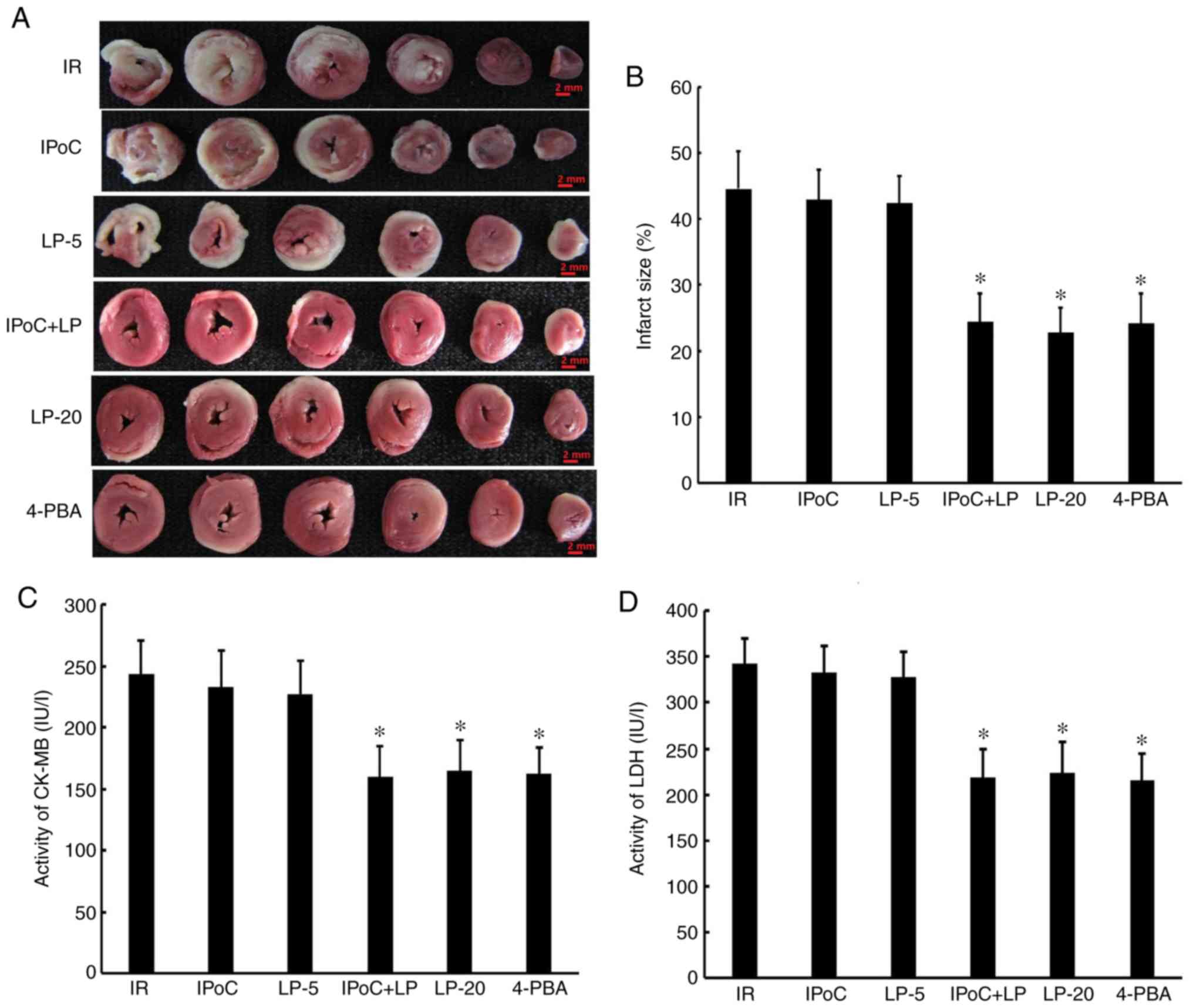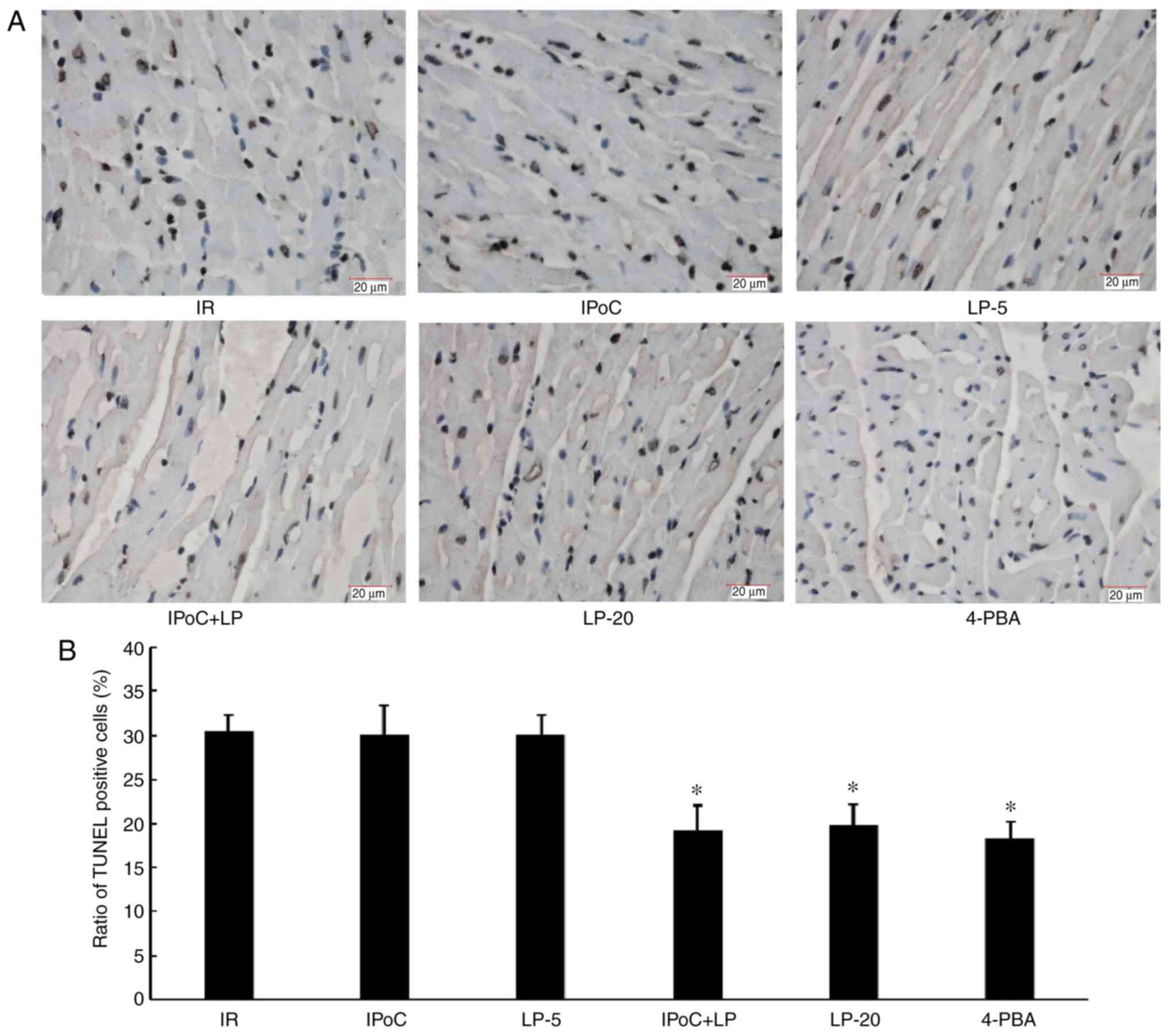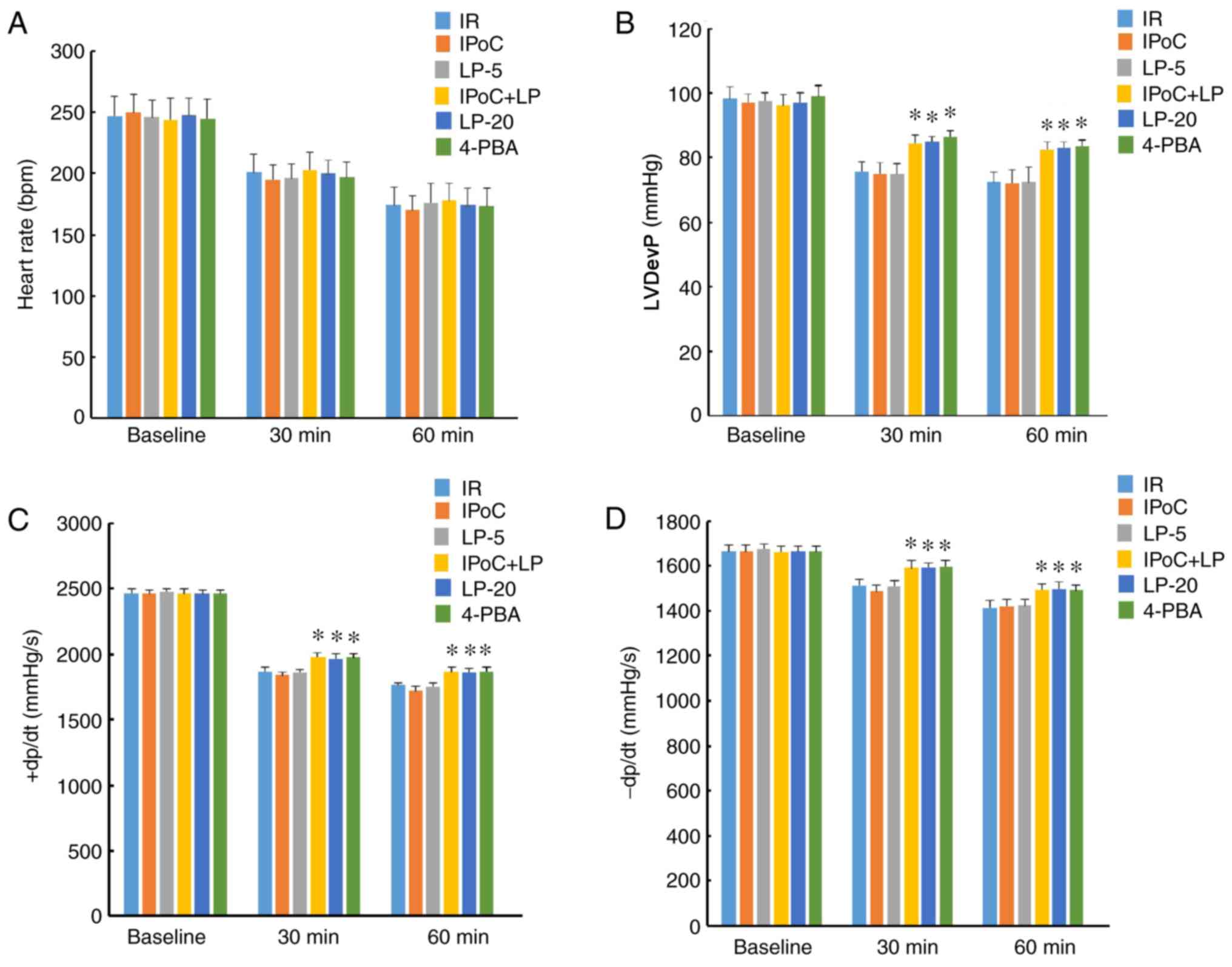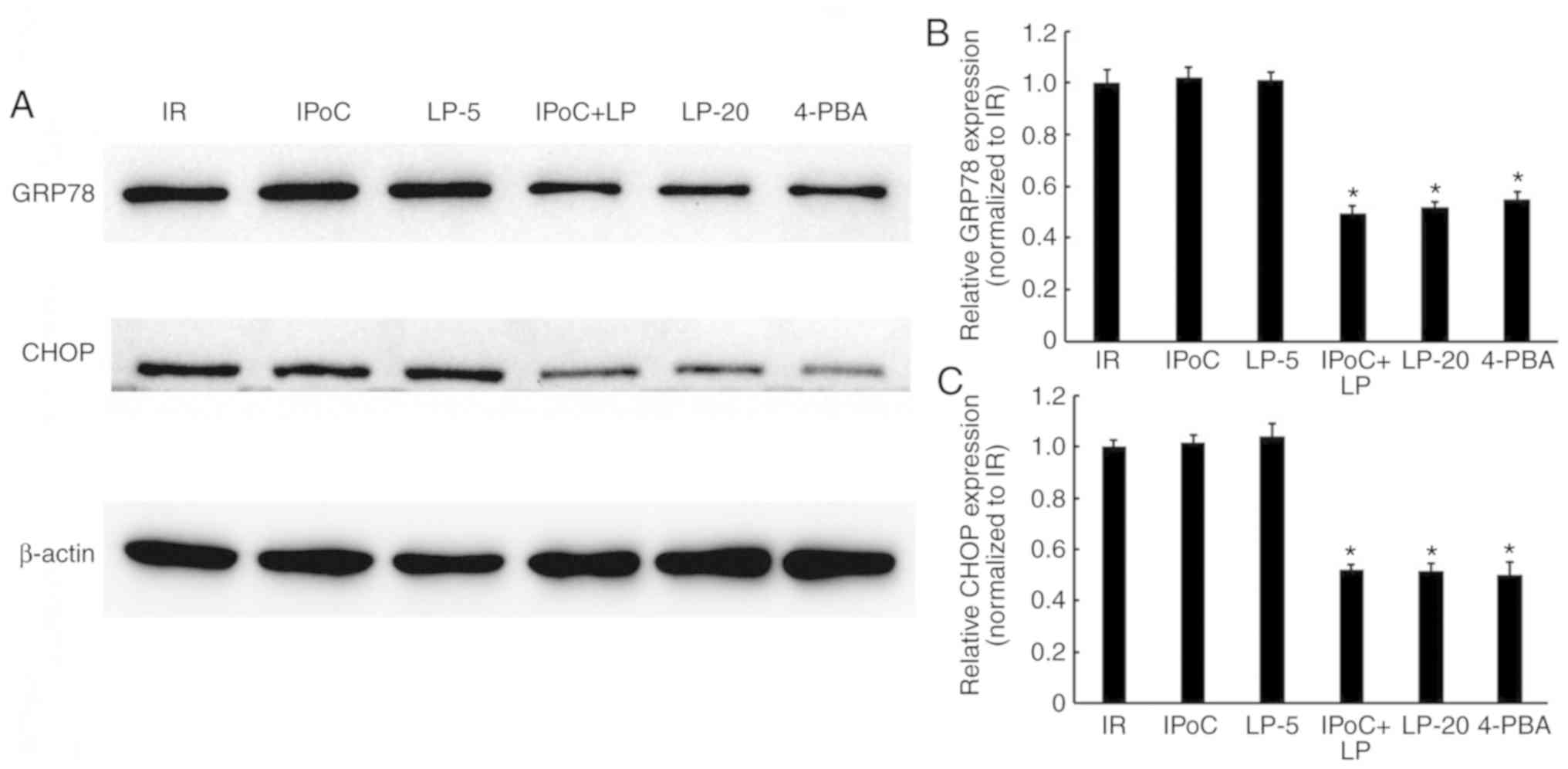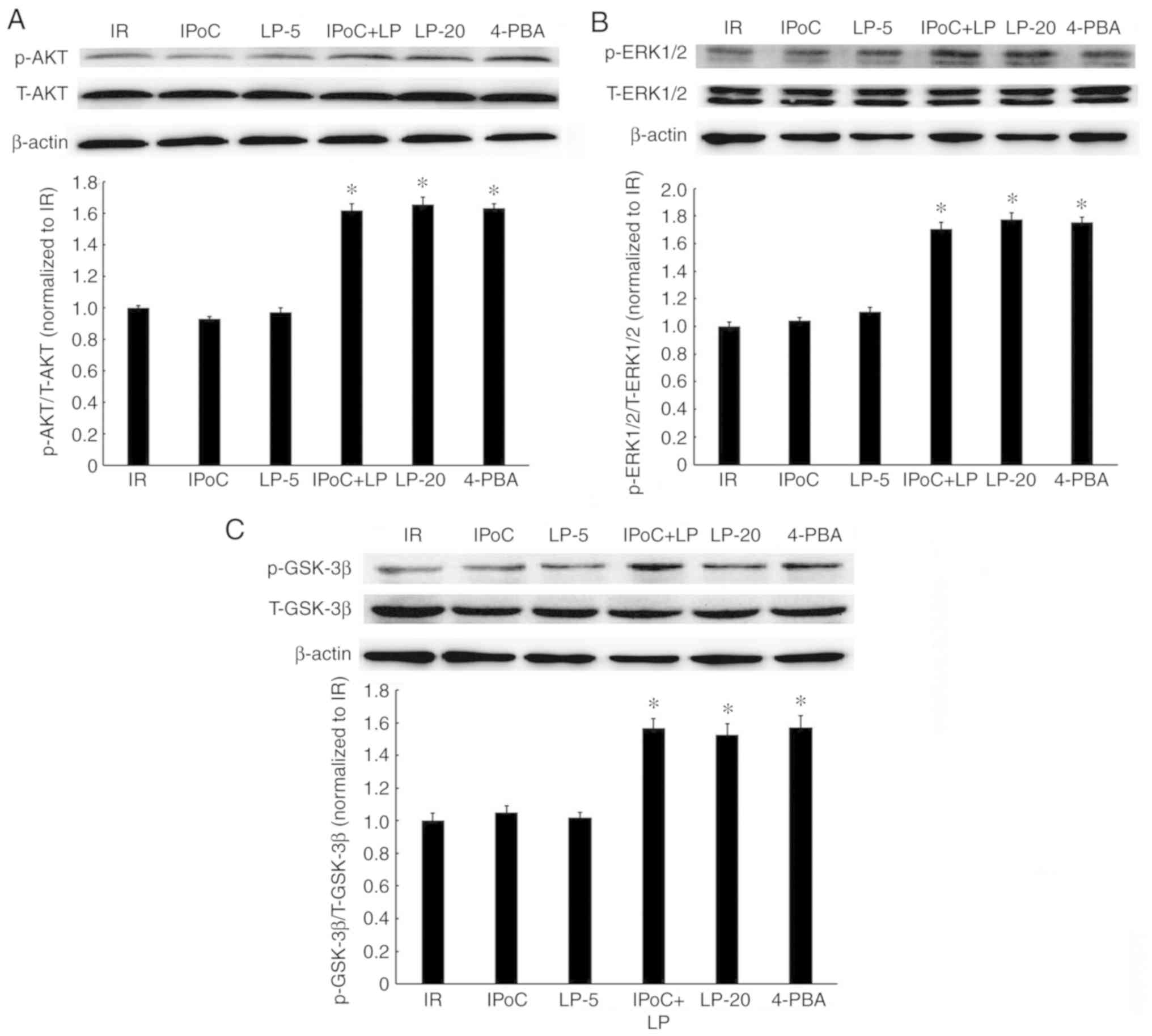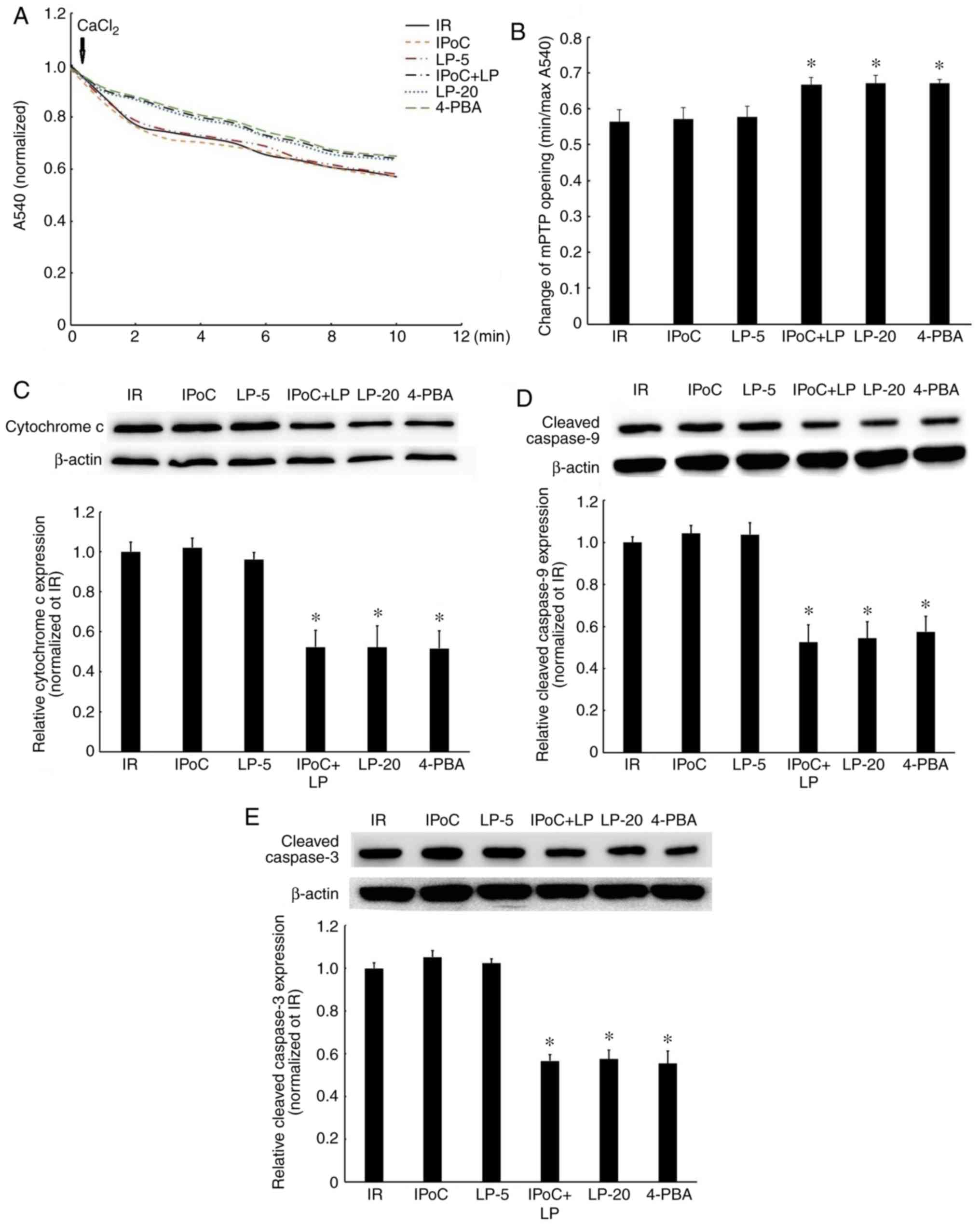Lycopene restores the effect of ischemic postconditioning on myocardial ischemia‑reperfusion injury in hypercholesterolemic rats
- Authors:
- Published online on: April 15, 2019 https://doi.org/10.3892/ijmm.2019.4166
- Pages: 2451-2461
-
Copyright: © Duan et al. This is an open access article distributed under the terms of Creative Commons Attribution License.
Abstract
Introduction
Preventing myocardial ischemia-reperfusion injury (MIRI) is a frequent problem during the application of reperfusion therapy, such as percutaneous coronary intervention in patients with ST-segment elevation myocardial infarction (1). Accumulating evidence has demonstrated that a short series of repetitive cycles of reperfusion and ischemia performed at the onset of sustained reperfusion, namely ischemic postconditioning (IPoC), attenuated MIRI in several animal models (2-6) and certain human studies (7,8). However, recent studies have reported that the cardioprotective effect of IPoC is usually abrogated by pathological conditions, including hypercholesterolemia (9), although the mechanism underlying the loss of cardioprotection in hypercholesterolemic animals remains elusive.
It is widely accepted that hypercholesterolemia is one of the most important risk factors for the development of atherosclerosis, but there is evidence that hypercholesterolemia also exerts direct negative effects on the myocardium itself (10), including increased endoplasmic reticulum (ER) stress (11), altered activation of signaling pathways (12,13) and induction of apoptosis (13), and some researchers believe that this may partly explain why the cardioprotective effect of IPoC is suppressed by hypercholesterolemia (14). For example, Andreadou et al (15) investigated whether hypercholesterolemia suppresses the protective effect of IPoC through a decrease in the phosphorylation of endothelial nitric oxide synthase (eNOS) and the production of nitric oxide (NO). Our previous studies demonstrated that the repression of IPoC by hypercholesterolemia is associated with inactivation of the reperfusion injury salvage kinase (RISK) pathway (13) and excessive mitochondrial permeability transition pore (mPTP) opening (12). Of note, it was observed that fasudil, a Rho-kinase inhibitor, restored the cardioprotective effect of IPoC in hypercholesterolemic rats by activating the PI3K/AKT/eNOS signaling pathway (16). Furthermore, it was demonstrated that blocking of mPTP opening with cyclosporine A could restore the benefits of IPoC in hypercholesterolemic rat hearts (17). Therefore, ameliorating the negative impact of hypercholesterolemia on the myocardium by pharmacological intervention appears to be a novel method for preserving or restoring the cardioprotection of IPoC under hypercholesterolemic conditions.
Lycopene (LP), a type of carotenoid present in tomatoes and other red fruits and vegetables, has potent antioxidant properties, and has been reported to reduce the risk of multiple diseases, including coronary heart disease (18). More importantly, several recent studies have demonstrated that LP protects against MIRI by inhibiting the development of ER stress (19) and blocking mPTP opening (20). Given that LP can alleviate the negative impact of hypercholesterolemia on the myocardium, we hypothesized that LP treatment may preserve or restore the protective effect of IPoC against MIRI in the presence of hypercholesterolemia.
The aim of the present study was to determine whether LP treatment could restore the cardioprotective effect of IPoC in hypercholesterolemic rat hearts, and elucidate the underlying mechanism.
Materials and methods
Animals and establishment of a hypercholesterolemic rat model
A total of 110 male Wistar rats, weighing 100±10 g, were purchased from Changsheng Biotechnology Co., Ltd. All rats were housed in an environment of constant temperature (22-25°C) and relative humidity (50-60%) on a 12/12 h light/dark cycle, and food and water were provided ad libitum. To establish the hypercholesterolemic rat model, the rats were divided in two groups as follows: i) High-cholesterol diet (HCD) group (n=90), rats were consecutively fed a cholesterol-enriched feedstuff, including 1.5% cholesterol, 10% egg yolk powder, 10% lard, 0.5% sodium cholate, 3% sugar and 75% normal feedstuff for 12 weeks; and ii) normal diet (ND) group (n=20), rats were consecutively fed normal feedstuff for the same time period. After 12 weeks, 1 ml blood samples were collected from the tail vein to determine the serum values of total cholesterol (TC), high-density lipoprotein-cholesterol and low-density lipoprotein (LDL)-cholesterol using commercial kits (Nanjing Jiancheng Bioengineering Institute, cat. nos. A111-1, A112-2 and A113-2) according to the manufacturer's instructions. All rats were handled according to the Guide for the Care and Use of Laboratory Animals (National Institutes of Health) (21). The experimental protocol was approved by the Institutional Ethics Committee of China Medical University (Shenyang, China).
Establishment of MIRI and IPoC model in isolated rat hearts
Heart preparation was performed as previously described (22). Briefly, the rats were anesthetized with intraperitoneal injection of pentobarbital sodium (30 mg/kg). Each rat heart was rapidly isolated and then placed into an iced heparinized K-H solution (NaCl 0.15 mol/l, KCl 0.006 mol/l, CaCl2 0.002 mol/l and NaHCO3 0.002 mol/l) for trimming. Subsequently, the isolated rat heart was rapidly mounted to the Langendorff apparatus through the aorta and perfused with K-H solution saturated with 95% O2 and 5% CO2 at 75 mmHg and 37°C. A water-filled latex balloon was inserted into the left ventricle through the left atrium and connected to a pressure transducer for pressure measurement. All isolated rat hearts were stabilized for 10 min before ischemia, and then subjected to 30 min global ischemia followed by 60 min reperfusion to create the MIRI model. As for the induction of IPoC, six cycles of brief ischemia/reperfusion [(10/10 sec) x6] were performed at the onset of sustained reperfusion.
Experimental protocol
Rats in the HCD group (n=90) were randomly divided into six groups with 15 rats per group as follows: i) IR group, isolated rat hearts were subjected to 30 min global ischemia followed by 60 min reperfusion, as previously described; ii) IPoC group, following 30 min of ischemia, six cycles of IPoC were performed at the onset of reperfusion, followed by 58 min of reperfusion; iii) 5 mg/kg/day LP treatment (LP-5) group, LP (CAS no. 502-65-8, purity ≥90%), purchased from Meilun Biological Technology Co. Ltd., was dissolved in corn oil (Sigma-Aldrich; Merck KGaA), rats were treated with LP (5 mg/kg/day) for 5 consecutive days then other experimental procedures were as described for the IR group; iv) IPoC + LP-5 group, rats were treated with LP (5 mg/kg/day) for 5 consecutive days, and then IPoC was performed as described for the IPoC group; v) 20 mg/kg/day LP treatment (LP-20) group, rats were treated with LP (20 mg/kg/d) for 5 consecutive days, then other experimental procedures were as described for the IR group; vi) sodium 4-phenylbutyrate treatment (4-PBA) group, 4-PBA (Sigma-Aldrich; Merck KGaA), an ER stress inhibitor, was intraperitoneally administered at a dose of 20 mg/kg 1 h prior to ischemia, then IR experimental procedures were as described for the IR group.
According to previous studies (23-25), the dose of LP used for intraperitoneal injection in rats ranged between 2.5 and 20 mg/kg/day; therefore, 5 mg/kg/day was selected as the low dose and 20 mg/kg/day as the high dose of LP treatment. Moreover, the period of LP treatment through intraperitoneal injection ranged between 1 and 10 days in previous studies. Therefore, an intermediate treatment period of 5 days was selected for this study. LP was administered intraperitoneally at a dose of 5 mg/kg/day for 5 consecutive days. The dose of 4-PBA was based on a previous study (26).
Measurement of changes in serum lipids after LP treatment
To assess whether LP has an effect on the level of serum lipids, 45 rats in the LP-5, IPoC + LP-5 and LP-20 group (n=15 per group) were performed lipid profile as described earlier, after received LP administration at a dose of 5 or 20 mg/kg/day for 5 consecutive days.
Observation of myocardial mitochondria by electron microscopy
At the end of the reperfusion period, a 1×1×1-mm piece of cardiac tissue was isolated from the left ventricle and electron microscopic sections were prepared as previously described (27). The morphological changes of the mitochondria were observed by transmission electron microscopy (JEM-1200EX; JEOL, Ltd.).
Hematoxylin and eosin staining
The hearts were removed from the perfusion apparatus at the end of the reperfusion period. The left ventricular heart tissues were fixed in 4% paraformaldehyde for 24 h at room temperature, dehydrated and embedded in paraffin. The paraffin blocks were then cut into 5-µm sections. The paraffin sections were dewaxed, stained with hematoxylin for 5 min, followed by 1% hydrochloric acid alcohol differentiation for 3 sec and eosin staining for 3 min at room temperature. The pathological changes in heart tissues were observed under a light microscope and imaged. To evaluate myocardial damage quantitatively, the sections were scored by two independent observers blinded to the experimental protocol, as previously described (28): 0, no damage; 1, interstitial edema and focal necrosis; 2, diffuse myocardial cell swelling and necrosis; 3, necrosis with the presence of contraction bands and neutrophil infiltrate; and 4, widespread necrosis with the presence of contraction bands, neutrophil infiltrate and hemorrhage.
Measurement of infarct size
Myocardial infarct size was measured by triphenyltetrazolium chloride (TTC) staining. The hearts were harvested at the end of the reperfusion period and the heart samples were frozen at −80°C for 30 min. The frozen hearts were cut into 1-2-mm sections from the apex to the bottom and incubated in 1% TTC solution at 37°C for 30 min. Subsequently, the heart sections were washed with 1X PBS and fixed in 4% paraformaldehyde overnight at room temperature. The stained sections were photographed by a digital camera and analyzed using ImageJ2x analysis software (National Institutes of Health). The severity of myocardial infarction was reflected by the ratio of infarct size to total size.
Measurement of lactate dehydrogenase (LDH) and creatine kinase muscle/brain isoenzyme (CK-MB) activity
LDH and CK-MB are released from cardiomyocytes into the coronary effluent during perfusion (29). The activities of LDH and CK-MB in the coronary effluent were determined using the LDH and CK-MB assay kits (Nanjing Jiancheng Bioengineering Institute; cat. nos. A020-1 and E006) according to the manufacturer's protocols. The absorbance value was detected at 450 nm by ultramicro microporous plate spectrophotometer (BioTek Instruments, Inc.).
Cardiac function monitoring
To evaluate the change in cardiac function, heart rate, left ventricular developed pressure (LVDevP), positive first-order derivative of ventricular pressure (+dp/dt) and negative first-order derivative of ventricular pressure (−dp/dt) were continuously recorded using a hemodynamic system (MP150; Biopac Systems, Inc.) during the IR and IPoC the experimental procedure.
Measurement of cardiomyocyte apoptosis
Myocardial cell apoptosis was detected by TUNEL assay using the In Situ Cell Death Detection Kit (Roche Diagnostics) according to the manufacturer's instructions. The apoptotic cells were observed under a light microscope and imaged.
Sensitivity of mPTP to calcium
The mitochondria were isolated from heart tissues using the Mitochondrial Extraction Kit (BestBio Science) according to the manufacturer's instructions. The sensitivity of mPTP to calcium was determined using the Purified Mitochondrial Membrane Pore Channel Colorimetric Assay kit (Shanghai Genmed Pharmaceutical Technology Co., Ltd.) according to the manufacturer's instructions.
Western blot analysis
The heart tissues were minced and homogenized with RIPA buffer (Beyotime Institute of Biotechnology). Following centrifugation, the supernatant was collected and protein concentrations were measured using a bicinchoninic acid protein concentration kit (Beyotime Institute of Biotechnology). After 30 µg protein was denatured at 100°C for 10 min, it was separated by SDS-PAGE on 8 or 10% and transferred to a PVDF membrane. The membrane was blocked using 5% skimmed milk for 1 h at room temperature, and then incubated with specific antibodies, including anti-glucose-regulated protein 78 (GRP78; 1:1,000; Abcam; cat. no. ab108613), anti-C/EBP homologous protein (CHOP; 1:1,000; Abcam; cat. no. ab11419), anti-AKT (1:1,000; Abcam; cat. no. ab179463), anti-phospho (p)-AKT (phospho S473; 1:1,000; Abcam; cat. no. ab81283), anti-ERK1/2 (1:1,000; Abcam; cat. no. ab17942), anti-p-ERK1/2 (phospho T202 + Y204; 1:1,000; Abcam; cat. no. ab214362), anti-glycogen synthase kinase-3β (GSK-3β; 1:1,000; Abcam; cat. no. ab93926), anti-p-GSK-3β (phospho S9; 1:1,000; Abcam; cat. no. ab107166), anti-cytochrome c (1:1,000; Abcam; cat. no. ab133504), anti-cleaved caspase-9 (1:1,000; Abcam; cat. no. ab2324), anti-cleaved caspase-3 (1:1,000; Abcam; cat. no. ab2302) and anti-β-actin (1:1,000; Zhongshan Jinqiao Biotechnology; cat. no. TA-09), at 4°C overnight. On the following day, the PVDF membrane was incubated with horseradish peroxidase-conjugated goat anti-rabbit IgG (1:4,000; EarthOx Life Science; cat. no. E030120-01) or goat anti-mouse IgG (1:4,000; EarthOx Life Science; cat. no. E030110-01) at room temperature for 30 min. Detection of protein bands was performed using an ECL for western blotting kit (Beyotime Institute of Biotechnology) according to the manufacturer's instructions. Relative densitometry was calculated with Image J2x analysis software.
Statistical analysis
All data are presented as mean ± SD and were analyzed using SPSS version 17.0 (SPSS, Inc., Chicago, IL, USA). Differences among three or more groups were first evaluated using one-way analysis of variance, and if the differences were significant, multiple comparison analysis was further performed with Fisher's least significant difference test. Differences between two groups were evaluated using independent samples t-test. P<0.05 was considered to indicate a statistically significant difference.
Results
Changes in serum lipids
The serum levels of TC and LDL were significantly increased in the HCD group as compared with the ND group after 12 weeks (Table I). The result suggested that the hypercholesterolemic rat model was successfully established. Moreover, there was no significant difference in the serum level of TC and LDL after a 5-day LP treatment either at the dose of 5 or 20 mg/kg/day (Table II), suggesting that short-term LP treatment did not affect the serum levels of TC and LDL.
Table IIAnalysis of the change in the serum lipid profile following lycopene (5 or 20 mg/kg/day) treatment. |
LP restores the protective effect of IPoC in hypercholesterolemic rats
In the IPoC + LP-5 group, the swelling of the mitochondria was reduced and mitochondrial cristae were denser, as observed by electron microscopy (Fig. 1A); myocardial degeneration and inflammatory infiltration were also less extensive, as observed by light microscopy (Fig. 1B and C); myocardial infarct size (Fig. 2A and B) and the release of CK-MB and LDH (Fig. 2C and D) were reduced and the apoptosis rate was decreased (Fig. 3), whereas cardiac function, as reflected by LVDevP and ±dp/dt, was improved (Fig. 4) in the IPoC + LP group compared with the IR group under conditions of hypercholesterolemia, although no beneficial effects were observed in the LP-5 and IPoC only groups. These results suggest that LP pretreatment may preserve or restore the cardioprotective effect of IPoC in hypercholesterolemic rats. Moreover, the LP-20 and 4-PBA groups displayed beneficial effects similar to the effects in the IPoC + LP-5 group, suggesting that high-dose LP treatment or pharmacological ER stress inhibition may protect hypercholesterolemic rats against MIRI.
Effects of LP, alone or combined with IPoC, on ER stress in hypercholesterolemic rats
As shown in Fig. 5, the protein expression of GRP78 and CHOP (markers of ER stress) was markedly decreased in the IPoC + LP-5 and LP-20 groups compared with IR and IPoC groups, which was similar to the effect of the ER stress inhibitor 4-PBA. However, no significant change was observed in the IPoC and LP-5 only groups. Therefore, high-dose LP or the combination of low-dose LP and IPoC were successful in reducing ER stress in hypercholesterolemic rats.
Effects of LP, alone or combined with IPoC, on the RISK pathway in hypercholesterolemic rats
Considering that the RISK pathway is suppressed in hypercholesterolemic rat hearts (12,13), the effect of LP, alone or combined with IPoC, on the activation of AKT, ERK1/2 and GSK-3β was investigated. The results revealed that the phosphorylation of AKT (Fig. 6A), ERK1/2 (Fig. 6B) and GSK-3β (Fig. 6C) were enhanced in the IPoC + LP-5, LP-20 and 4-PBA groups, compared with the IR group. However, no significant change in the phosphorylation levels of AKT, ERK1/2 or GSK-3β was observed in the IPoC and LP-5 only groups. Thus, high-dose LP or the combination of low-dose LP and IPoC successfully activated the RISK pathway in hypercholesterolemic rats.
Effects of LP, alone or combined with IPoC, on mPTP opening in hypercholesterolemic rats
mPTP is the end effector of IPoC and is regulated by the RISK pathway (30). Thus, the effect of LP, alone or combined with IPoC, on mPTP opening was investigated. The results demonstrated that the sensitivity of mPTP to calcium, an inducer of mPTP opening (31), was markedly decreased in the IPoC + LP-5, LP-20 and 4-PBA groups, compared with the IR group (Fig. 7A and B), but no significant change was observed in the IPoC and LP-5 groups. mPTP opening may lead to the activation of the mitochondrial apoptosis pathway. As expected, the expressions of mitochondrial apoptosis-related proteins, including cytochrome c, cleaved caspase-9 and cleaved caspase-3, were also reduced in the LP-5, LP-20 and 4-PBA groups, compared with the IR group (Fig. 7C-E), but no significant change was observed in the IPoC and LP-5 only groups, which was in accordance with the extent of mPTP opening. Taken together, these results confirmed that high-dose LP or the combination of low-dose LP and IPoC inhibit mPTP opening in hypercholesterolemic rat hearts.
Discussion
Whether the cardioprotective effect of IPoC is suppressed by hypercholesterolemia remains controversial (14). The results of the present study demonstrated that the cardioprotection of IPoC is lost in rats fed a high-cholesterol diet for 12 weeks, which is consistent with previous findings in mini-swine fed a cholesterol-enriched diet for 4 weeks (32) and rabbits fed a cholesterol-enriched diet for 6 weeks (33). However, Donato et al (34) reported that the cardioprotection of IPoC was preserved in rabbits after 4 weeks on a cholesterol-enriched diet. It is hypothesized that this discrepancy may be partly attributed to the differences in the duration of the cholesterol-enriched diet and the animal species.
Statins, a widely used class of lipid-lowering drugs, were found to restore the loss of IPoC benefits in hypercholesterolemic animals. Iliodromitis et al (35) first reported that the loss of the IPoC benefits may be reversed in hypercholester-olemic rabbits that received a 3-week simvastatin treatment due to the decrease in TC and LDL plasma levels and attenuation of the oxidative and nitrosative stress in the ischemic myocardium. Moreover, Andreadou et al (15) reported that a 3-day pravastatin treatment preserved the cardioprotective effect of IPoC in hypercholesterolemic rabbits, independently of any lipid-lowering effects, potentially through eNOS activation and the attenuation of nitro-oxidative stress. In the present study, a 5-day LP treatment achieved no decrease in serum lipids, but the combination of low-dose LP and IPoC attenuated MIRI in hypercholesterolemic rats. Although LP has antihyperlipidemic properties, its lipid-lowering effect usually requires long-term treatment. Zeng et al (36) found that the values of TC and LDL had not significantly changed when measured after 1 week of LP treatment, but exhibited a significant decrease after ≥3 weeks of LP treatment. This may explain why blood lipid levels had not decreased after a 5-day LP treatment in the present study. Given that the cardioprotective effect of IPoC is abolished by hypercholesterolemia, LP administration may preserve or restore the protective effect of IPoC in hypercholesterolemic rats, independently of any lipid-lowering effects. Interestingly, it was also observed that hypercholesterolemic rats treated with high-dose LP alone exhibited similar cardioprotection as those receiving a combination of low-dose LP and IPoC. Thus, it may be further inferred that LP in combination with IPoC exerts synergistic or additive protective effects against MIRI in hypercholesterolemic rats. Although high-dose LP treatment exerted protective effects in IR hearts under conditions of hypercholesterolemia, its side effects on other organs could not be determined due to the isolated rat heart model used in the present study, which is a potential limitation for its use in clinical practice. In contrast to high-dose LP treatment, low-dose LP combined with IPoC exerted similar cardioprotective effects, but was associated with fewer potential side effects due to the lower LP dose; for instance, high doses of LP may increase the risk of lung cancer in smokers (37,38). Therefore, combined treatment may represent a safer method for preventing MIRI in patients with hypercholesterolemia.
ER is responsible for the biosynthesis of all secreted and membrane proteins. The accumulation and aggregation of unfolded proteins in the ER leads to a condition referred to as ER stress (39). The unfolded protein response is initially activated to degrade unfolded proteins and restore normal ER function. If ER stress is prolonged, or if the adaptive response fails, the cells will die through apoptosis (40). Thus, ER stress is crucial for most cellular activities and survival. GRP78 and CHOP, two major ER stress-related proteins, reflect the activation of ER stress. The levels of GRP78 and CHOP were found to increase in the ischemic myocardium by the combination of low-dose LP and IPoC, which is similar to the effects of ER stress inhibitors, such as 4-PBA. Considering that hypercholesterolemia increases ER stress in the IR myocardium (11) and LP reduces ER stress in hypoxic-reoxygenated cardiomyocytes (19), it may be deduced that the restoration of IPoC in hypercholesterolemic rat by LP treatment may be mediated via inhibition of ER stress.
IPoC protects against MIRI through activation of the RISK pathway (AKT and ERK1/2) (41), and subsequently inhibiting GSK-3β and mPTP opening (42); however, hypercholesterolemia suppresses the activation of the RISK pathway and induces the activation of GSK-3β and mPTP opening (12,13). In the present study, the combination of LP and IPoC activated AKT and ERK1/2, subsequently inhibiting GSK-3β and mPTP opening in hypercholesterolemic rat hearts, suggesting that the restoration of IPoC by LP may be partly attributed to the reactivation of the RISK pathway. ER stress has been demonstrated to impair the activation of the RISK pathway (43). Miki et al (43) provided evidence that ER stress may suppress the phosphorylation of AKT and ERK1/2, and further impair GSK-3β-mediated suppression of mPTP opening. Notably, the combination of LP and IPoC exerted the same effect on the RISK pathway as that of an ER stress inhibitor. Thus, it may be inferred that LP reactivates AKT and ERK1/2 in hypercholesterolemic rat hearts partly through inhibition of ER stress.
There were certain limitations to the present study. First, although LP restored the cardioprotection of IPoC in hypercholesterolemic rats by inhibition of ER stress and activation of the RISK pathway, whether activating ER stress or inhibiting the RISK pathway by a pharmacological or genetic approach could reverse the restoration of IPoC in hypercholesterolemic rats was not determined. Therefore, these conclusions should be further confirmed in future studies. Second, MIRI was mimicked in isolated rat hearts using a Langendorff apparatus. In this model, the ischemic heart was only subjected to 60-120 min reperfusion and then harvested (44). Therefore, cardiac fibrosis or remodeling, including changes in histology and protein biomarkers (matrix metallopeptidase-2/-9 and cathepsins S/K) (45-48), could not be observed in this model within this short period of time. Finally, considerable evidence indicates that reactive oxygen species (ROS) have a predominant role in myocardial damage induced by reperfusion (49,50). However, the present study mainly focused on the role of the regulation of ER stress and the RISK signaling pathway in the restoration of IPoC by LP under hypercholesterolemic conditions and the lack of ROS detection is a limitation of the present study. Additional mechanisms that may be involved in this process, such as oxidative stress mediated by ROS, require further investigation.
Collectively, to the best of our knowledge, the findings of the present study are the first to demonstrate that LP restores the cardioprotective effect of IPoC in hypercholesterolemic rats. Furthermore, the restoration of IPoC by LP in hypercholesterolemic rat hearts was found to be associated with the inhibition of ER stress and activation of the RISK pathway. Given that LP is non-toxic and has fewer adverse effects compared with statins, the combination of LP and IPoC may be a novel therapy for preventing MIRI in patients with hypercholesterolemia that receive percutaneous coronary intervention.
Funding
This study was supported by the National Natural Science Foundation of China (grant nos. 81670320 and 81800232) and the Natural Science Foundation of Liaoning Province (grant no. 201602826).
Availability of data and materials
The datasets generated and analyzed during the present study are available from the corresponding author on reasonable request.
Authors' contributions
DJ and NW conceived and designed the experiments. LD conducted the experiments. CL, XL, ZH and SL participated in the completion of the experiments. LD and NW analyzed the data. LD wrote the paper. All authors read and approved the final version of this manuscript.
Ethics approval and consent to participate
The experimental protocol was approved by the Institutional Ethics Committee of China Medical University.
Patient consent for publication
Not applicable.
Competing interests
The authors declare that they have no competing interests.
Acknowledgments
Not applicable.
References
|
Bulluck H, Yellon DM and Hausenloy DJ: Reducing myocardial infarct size: Challenges and future opportunities. Heart. 102:341–348. 2016. View Article : Google Scholar : | |
|
Zhao ZQ, Corvera JS, Halkos ME, Kerendi F, Wang NP, Guyton RA and Vinten-Johansen J: Inhibition of myocardial injury by ischemic postconditioning during reperfusion: Comparison with ischemic preconditioning. Am J Physiol Heart Circ Physiol. 285:H579–H588. 2003. View Article : Google Scholar : PubMed/NCBI | |
|
Shinohara G, Morita K, Nagahori R, Koh Y, Kinouchi K, Abe T and Hashimoto K: Ischemic postconditioning promotes left ventricular functional recovery after cardioplegic arrest in an in vivo piglet model of global ischemia reperfusion injury on cardiopulmonary bypass. J Thorac Cardiovasc Surg. 142:926–932. 2011. View Article : Google Scholar : PubMed/NCBI | |
|
You L, Li L, Xu Q, Ren J and Zhang F: Postconditioning reduces infarct size and cardiac myocyte apoptosis via the opioid receptor and JAK-STAT signaling pathway. Mol Biol Rep. 38:437–443. 2011. View Article : Google Scholar | |
|
Cao S, Liu Y, Wang H, Mao X, Chen J, Liu J, Xia Z, Zhang L, Liu X and Yu T: Ischemic postconditioning influences electron transport chain protein turnover in Langendorff-perfused rat hearts. Peer J. 4:e17062016. View Article : Google Scholar : PubMed/NCBI | |
|
Tong G, Aponte AM, Kohr MJ, Steenbergen C, Murphy E and Sun J: Postconditioning leads to an increase in protein S-nitrosylation. Am J Physiol Heart Circ Physiol. 306:H825–H832. 2014. View Article : Google Scholar : PubMed/NCBI | |
|
Araszkiewicz A, Grygier M, Pyda M, Rajewska J, Michalak M, Lesiak M and Grajek S: Postconditioning reduces enzymatic infarct size and improves microvascular reperfusion in patients with ST-segment elevation myocardial infarction. Cardiology. 129:250–257. 2014. View Article : Google Scholar : PubMed/NCBI | |
|
Araszkiewicz A, Grygier M, Pyda M, Rajewska J, Lesiak M and Grajek S: Postconditioning attenuates early ventricular arrhythmias in patients with high-risk ST-segment elevation myocardial infarction. J Cardiol. 65:459–465. 2015. View Article : Google Scholar : PubMed/NCBI | |
|
Ferdinandy P, Hausenloy DJ, Heusch G, Baxter GF and Schulz R: Interaction of risk factors, comorbidities, and comedications with ischemia/reperfusion injury and cardioprotection by preconditioning, postconditioning, and remote conditioning. Pharmacol Rev. 66:1142–1174. 2014. View Article : Google Scholar : PubMed/NCBI | |
|
D'Annunzio V, Donato M, Buchholz B, Pérez V, Miksztowicz V, Berg G and Gelpi RJ: High cholesterol diet effects on ischemia-reperfusion injury of the heart. Can J Physiol Pharmacol. 90:1185–1196. 2012. View Article : Google Scholar : PubMed/NCBI | |
|
Wu N, Zhang X, Jia P and Jia D: Hypercholesterolemia aggravates myocardial ischemia reperfusion injury via activating endoplasmic reticulum stress-mediated apoptosis. Exp Mol Pathol. 99:449–454. 2015. View Article : Google Scholar : PubMed/NCBI | |
|
Wu N, Zhang X, Guan Y, Shu W, Jia P and Jia D: Hypercholesterolemia abrogates the cardioprotection of ischemic postconditioning in isolated rat heart: Roles of glycogen synthase kinase-3β and the mitochondrial permeability transition pore. Cell Biochem Biophys. 69:123–130. 2014. View Article : Google Scholar | |
|
Wu N, Zhang X, Jia P and Jia D: Hypercholesterolemia abrogates the protective effect of ischemic postconditioning by induction of apoptosis and impairment of activation of reperfusion injury salvage kinase pathway. Biochem Biophys Res Commun. 458:148–153. 2015. View Article : Google Scholar : PubMed/NCBI | |
|
Andreadou I, Iliodromitis EK, Lazou A, Görbe A, Giricz Z, Schulz R and Ferdinandy P: Effect of hypercholesterolaemia on myocardial function, ischaemia-reperfusion injury and cardio-protection by preconditioning, postconditioning and remote conditioning. Br J Pharmacol. 174:1555–1569. 2017. View Article : Google Scholar : PubMed/NCBI | |
|
Andreadou I, Farmakis D, Prokovas E, Sigala F, Zoga A, Spyridaki K, Papalois A, Papapetropoulos A, Anastasiou-Nana M, Kremastinos DT and Iliodromitis EK: Short-term statin administration in hypercholesterolaemic rabbits resistant to postconditioning: Effects on infarct size, endothelial nitric oxide synthase, and nitro-oxidative stress. Cardiovasc Res. 94:501–509. 2012. View Article : Google Scholar : PubMed/NCBI | |
|
Wu N, Li W, Shu W, Lv Y and Jia D: Inhibition of Rho-kinase by fasudil restores the cardioprotection of ischemic postcondi-tioninng in hypercholesterolemic rat heart. Mol Med Rep. 10:2517–2524. 2014. View Article : Google Scholar : PubMed/NCBI | |
|
Wu N, Li WN, Shu WQ, Lv Y and Jia DL: Blocking the mitochondrial permeability transition pore with cyclosporine-A can restore cardioprotection of ischemic postconditioning in hypercholesterolemic rat heart. Eur Rev Med Pharmacol Sci. 19:446–454. 2015.PubMed/NCBI | |
|
Riccioni G, Mancini B, Di Ilio E, Bucciarelli T and D'Orazio N: Protective effect of lycopene in cardiovascular disease. Eur Rev Med Pharmacol Sci. 12:183–190. 2008.PubMed/NCBI | |
|
Xu J, Hu H, Chen B, Yue R, Zhou Z, Liu Y, Zhang S, Xu L, Wang H and Yu Z: Lycopene protects against hypoxia/reoxygenation injury by alleviating ER stress induced apoptosis in neonatal mouse cardiomyocytes. PLoS One. 10:e01364432015. View Article : Google Scholar : PubMed/NCBI | |
|
Yue R, Hu H, Yiu KH, Luo T, Zhou Z, Xu L, Zhang S, Li K and Yu Z: Lycopene protects against hypoxia/reoxygenation-induced apoptosis by preventing mitochondrial dysfunction in primary neonatal mouse cardiomyocytes. PLoS One. 7:e507782012. View Article : Google Scholar : PubMed/NCBI | |
|
Kastenmayer RJ, Moore RM, Bright AL, Torres-Cruz R and Elkins WR: Select agent and toxin regulations: Beyond the eighth edition of the guide for the care and use of laboratory animals. J Am Assoc Lab Anim Sci. 51:333–338. 2012.PubMed/NCBI | |
|
Jia P, Liu C, Wu N, Jia D and Sun Y: Agomelatine protects against myocardial ischemia reperfusion injury by inhibiting mitochondrial permeability transition pore opening. Am J Transl Res. 10:1310–1323. 2018.PubMed/NCBI | |
|
Bayramoglu G, Bayramoglu A, Altuner Y, Uyanoglu M and Colak S: The effects of lycopene on hepatic ischemia/reperfusion injury in rats. Cytotechnology. 67:487–491. 2015. View Article : Google Scholar : | |
|
Göncü T, Oğuz E, Sezen H, Koçarslan S, Oğuz H, Akal A, Adıbelli FM, Çakmak S and Aksoy N: Anti-inflammatory effect of lycopene on endotoxin-induced uveitis in rats. Arq Bras Oftalmol. 79:357–362. 2016. View Article : Google Scholar | |
|
Güzel M, Sönmez MF, Baştuğ O, Aras NF, Öztürk AB, Küçükaydın M and Turan C: Effectiveness of lycopene on experimental testicular torsion. J Pediatr Surg. 51:1187–1191. 2016. View Article : Google Scholar | |
|
Grall S, Prunier-Mirebeau D, Tamareille S, Mateus V, Lamon D, Furber A and Prunier F: Endoplasmic reticulum stress pathway involvement in local and remote myocardial ischemic conditioning. Shock. 39:433–439. 2013. View Article : Google Scholar : PubMed/NCBI | |
|
Jia D: The protective effect of mitochondrial ATP-sensitive K+ channel opener, nicorandil, combined with Na+/Ca2+ exchange blocker KB-R7943 on myocardial ischemia-reperfusion injury in rat. Cell Biochem Biophys. 60:219–224. 2011. View Article : Google Scholar | |
|
Zingarelli B, Salzman AL and Szabó C: Genetic disruption of poly (ADP-ribose) synthetase inhibits the expression of P-selectin and intercellular adhesion molecule-1 in myocardial ischemia/reperfusion injury. Circ Res. 83:85–94. 1998. View Article : Google Scholar : PubMed/NCBI | |
|
Wu N, Zhang X and Jia D: High-dose fasudil preconditioning and postconditioning attenuate myocardial ischemia-reperfusion injury in hypercholesterolemic rats. Mol Med Rep. 9:560–566. 2014. View Article : Google Scholar | |
|
Hausenloy DJ, Tsang A and Yellon DM: The reperfusion injury salvage kinase pathway: A common target for both ischemic preconditioning and postconditioning. Trends Cardiovasc Med. 15:69–75. 2005. View Article : Google Scholar : PubMed/NCBI | |
|
Zhu H, Ding Y, Xu X, Li M, Fang Y, Gao B, Mao H, Tong G, Zhou L and Huang J: Prostaglandin E1 protects coronary microvascular function via the glycogen synthase kinase 3β-mitochondrial permeability transition pore pathway in rat hearts subjected to sodium laurate-induced coronary microembolization. Am J Transl Res. 9:2520–2534. 2017. | |
|
Zhao JL, Yang YJ, You SJ, Cui CJ and Gao RL: Different effects of postconditioning on myocardial no-reflow in the normal and hypercholesterolemic mini-swines. Microvasc Res. 73:137–142. 2007. View Article : Google Scholar | |
|
Iliodromitis EK, Zoga A, Vrettou A, Andreadou I, Paraskevaidis IA, Kaklamanis L and Kremastinos DT: The effectiveness of postconditioning and preconditioning on infarct size in hypercho-lesterolemic and normal anesthetized rabbits. Atherosclerosis. 188:356–362. 2006. View Article : Google Scholar | |
|
Donato M, D'Annunzio V, Berg G, Gonzalez G, Schreier L, Morales C, Wikinski RL and Gelpi RJ: Ischemic postconditioning reduces infarct size by activation of A1 receptors and K+(ATP) channels in both normal and hypercholesterolemic rabbits. J Cardiovasc Pharmacol. 49:287–292. 2007. View Article : Google Scholar : PubMed/NCBI | |
|
Iliodromitis EK, Andreadou I, Prokovas E, Zoga A, Farmakis D, Fotopoulou T, Ioannidis K, Paraskevaidis IA and Kremastinos DT: Simvastatin in contrast to postconditioning reduces infarct size in hyperlipidemic rabbits: Possible role of oxidative/nitrosative stress attenuation. Basic Res Cardiol. 105:193–203. 2010. View Article : Google Scholar : PubMed/NCBI | |
|
Zeng YC, Hu MY, Qu SL and Zhou GY: Effects of lycopene on blood lipid and red blood cell of rat with hypercholesterolemia. Zhonghua Yu Fang Yi Xue Za Zhi. 43:1064–1068. 2009.In Chinese. | |
|
Paolini M, Abdel-Rahman SZ, Sapone A, Pedulli GF, Perocco P, Cantelli-Forti G and Legator MS: Beta-carotene: A cancer chemo-preventive agent or a co-carcinogen. Mutat Res. 543:195–200. 2003. View Article : Google Scholar : PubMed/NCBI | |
|
Yeh SL and Hu ML: Induction of oxidative DNA damage in human foreskin fibroblast Hs68 cells by oxidized beta-Carotene and lycopene. Free Radic Res. 35:203–213. 2001. View Article : Google Scholar : PubMed/NCBI | |
|
Rasheva VI and Domingos PM: Cellular responses to endoplasmic reticulum stress and apoptosis. Apoptosis. 14:996–1007. 2009. View Article : Google Scholar : PubMed/NCBI | |
|
Szegezdi E, Logue SE, Gorman AM and Samali A: Mediators of endoplasmic reticulum stress-induced apoptosis. EMBO Rep. 7:880–885. 2006. View Article : Google Scholar : PubMed/NCBI | |
|
Sivaraman V, Mudalagiri NR, Di Salvo C, Kolvekar S, Hayward M, Yap J, Keogh B, Hausenloy DJ and Yellon DM: Postconditioning protects human atrial muscle through the activation of the RISK pathway. Basic Res Cardiol. 102:453–459. 2007. View Article : Google Scholar : PubMed/NCBI | |
|
Gomez L, Paillard M, Thibault H, Derumeaux G and Ovize M: Inhibition of GSK3beta by postconditioning is required to prevent opening of the mitochondrial permeability transition pore during reperfusion. Circulation. 117:2761–2768. 2008. View Article : Google Scholar : PubMed/NCBI | |
|
Miki T, Miura T, Hotta H, Tanno M, Yano T, Sato T, Terashima Y, Takada A, Ishikawa S and Shimamoto K: Endoplasmic reticulum stress in diabetic hearts abolishes erythropoietin-induced myocardial protection by impairment of phosphoglycogen synthase kinase-3beta-mediated suppression of mitochondrial permeability transition. Diabetes. 58:2863–2872. 2009. View Article : Google Scholar : PubMed/NCBI | |
|
Bell RM, Mocanu MM and Yellon DM: Retrograde heart perfusion: The Langendorff technique of isolated heart perfusion. J Mol Cell Cardiol. 50:940–950. 2011. View Article : Google Scholar : PubMed/NCBI | |
|
Hu L, Cheng XW, Song H, Inoue A, Jiang H, Li X, Shi GP, Kozawa E, Okumura K and Kuzuya M: Cathepsin K activity controls injury-related vascular repair in mice. Hypertension. 63:607–615. 2014. View Article : Google Scholar : | |
|
Cheng Wu H, Hu XW, Takeshita L, Hu K, Du C, Li Q, Zhu X, Huang E, Yisireyili ZM, et al: Cathepsin S activity controls injury-related vascular repair in mice via the TLR2-mediated p38MAPK and PI3K-Akt/p-HDAC6 signaling pathway. Arterioscler Thromb Vasc Biol. 36:1549–1557. 2016. View Article : Google Scholar : PubMed/NCBI | |
|
Cheng XW, Shi GP, Kuzuya M, Sasaki T, Okumura K and Murohara T: Role for cysteine protease cathepsins in heart disease: Focus on biology and mechanisms with clinical implication. Circulation. 125:1551–1562. 2012. View Article : Google Scholar : PubMed/NCBI | |
|
Ogasawara S, Cheng XW, Inoue A, Hu L, Piao L, Yu C, Goto H, Xu W, Zhao G, Lei Y, et al: Cathepsin K activity controls cardiotoxin-induced skeletal muscle repair in mice. J Cachexia Sarcopenia Muscle. 9:160–175. 2018. View Article : Google Scholar | |
|
Cadenas S: ROS and redox signaling in myocardial ischemia-reperfusion injury and cardioprotection. Free Radic Biol Med. 117:76–89. 2018. View Article : Google Scholar : PubMed/NCBI | |
|
Andrienko TN, Pasdois P, Pereira GC, Ovens MJ and Halestrap AP: The role of succinate and ROS in reperfusion injury-A critical appraisal. J Mol Cell Cardiol. 110:1–14. 2017. View Article : Google Scholar : PubMed/NCBI |



